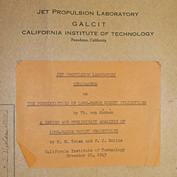tl;dr: Except for the 1939 lunar lander, it seems the projects undertaken during the "JPL's Army years" were related to weaponry (WW2 and after) rather than space exploration. So while the name "Jet Propulsion Laboratory" remained the same, the actual entity we associate with space exploration was not really the one founded by said individuals. The linked article in the question glosses over this difference and tries to create the impression that Qian's JPL is associated with NASA or the exploration of space in some way, which is not the case.
Sputnik changed everything.
From https://trs.jpl.nasa.gov/handle/2014/39699 Keymeulen, Didier; Myers, John; Newton, Jason; Csaszar, Ambrus; et al. (2006). Humanoids for Lunar and Planetary Surface Operations. Jet Propulsion Laboratory, National Aeronautics and Space Administration. Pasadena, CA: JPL TRS 1992+ Humanoids for lunar and planetary surface operations
JPL is a child of Caltech: founded in 1936 as a graduate student project under
Professor Theodore von Kármán.
- JPL led the development of US rocket technology in WWII.
- Caltech and JPL staff founded Aerojet Corporation, the first US rocket firm.
- JPL worked in collaboration with Werner von Braun and German rocket engineers
to create the US missile program from 1946 to 1958.
- JPL worked under a US Army Ballistic Missile Agency contract to design and build
the Corporal and Sergeant, the first US ballistic missiles.
- After Sputnik, JPL was transferred to NASA upon its creation in 1958.
Qian Xuesen (钱学森) was indeed part of the beginnings of what was first called the Jet Propulsion Laboratory in 1943:
In 1943, Tsien and two other members of their rocketry group drafted the first document to use the name Jet Propulsion Laboratory, originally a proposal to the Army for developing missiles in response to Germany's V-2 rocket. This led to Private A, which flew in 1944, and later the Corporal, the WAC Corporal, and other designs.
Von Kármán wrote of Tsien, "At the age of 36, he was an undisputed genius whose work was providing an enormous impetus to advances in high-speed aerodynamics and jet propulsion."13 During this time, he worked on designing an intercontinental space plane, which would later inspire the X-20 Dyna-Soar, a precursor to the American Space Shuttle.
13Perrett, Bradley (2008-01-06). "Qian Xuesen Laid Foundation For Space Rise in China". Aviation Week and Space Technology. 168 (1). Archived from the original on 2011-05-21. Retrieved 2 February 2015.
though it was primarily for weapons design during WW2, and substantially different than the JPL we know today.
According to Wikipedia's Jet Propulsion Laboratory:
n 1941, Malina, Parsons, Forman, Martin Summerfield, and pilot Homer Bushey demonstrated the first jet-assisted takeoff (JATO) rockets to the Army. In 1943, von Kármán, Malina, Parsons, and Forman established the Aerojet Corporation to manufacture JATO rockets. The project took on the name Jet Propulsion Laboratory in November 1943, formally becoming an Army facility operated under contract by the university. (emphasis added)
[...]
During JPL's Army years, the laboratory developed two deployed weapon systems, the MGM-5 Corporal and MGM-29 Sergeant intermediate range ballistic missiles. These missiles were the first US ballistic missiles developed at JPL.7 It also developed a number of other weapons system prototypes, such as the Loki anti-aircraft missile system, and the forerunner of the Aerobee sounding rocket. At various times, it carried out rocket testing at the White Sands Proving Ground, Edwards Air Force Base, and Goldstone, California. A lunar lander was also developed in 1938-39 which influenced design of the Apollo Lunar Module in the 1960s.6
6Launius, Roger (2002). To Reach High Frontier, A History of U.S. Launch Vehicles. University of Kentucky. pp. 39–42.
7Keymeulen, Didier; Myers, John; Newton, Jason; Csaszar, Ambrus; et al. (2006). Humanoids for Lunar and Planetary Surface Operations. Jet Propulsion Laboratory, National Aeronautics and Space Administration. Pasadena, CA: JPL TRS 1992+ Humanoids for lunar and planetary surface operations
Except for the 1939 lunar lander, it seems the projects undertaken were related to weaponry rather than space exploration. So while the name "Jet Propulsion Laboratory" remained the same, the actual entity we associate with space exploration was not really founded by said individuals.


Source Original and zoomed/sharpened. I cant' find a larger size, sorry.
NOVEMBER 20, 1943
First Use of the Name "Jet Propulsion Laboratory"
Theodore von Kármán and his Caltech research team propose to the U.S. Army Air Corps a research project to understand, duplicate and reach beyond the German rocket program. In the proposal, the team refers to their organization for the first time as "the Jet Propulsion Laboratory."

Source
The young rocketeers were encouraged by Caltech professor and aerodynamicist Theodore von Karman. After the mid-November tests, he secured space for them on the Caltech campus. He also insisted that the experimenters know the mathematics that described the performance of their rocket motors.
Over time, the inventors' explosive and noisy motors proved too dangerous for the campus. In 1940, a new facility -- across the Arroyo from the original test site -- was built in the foothills of Pasadena. Three test stands and tarpaper shacks marked the first buildings of what von Karman would name the Jet Propulsion Laboratory in November 1943. He would become JPL's first director.


